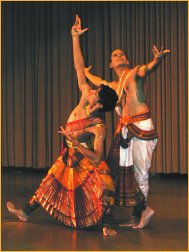 |
 |
Mahatma - from truth to enlightenment by Emily Raabe, Philadelphia e-mail: eraabe@philamuseum.org October 6, 2003 Mahatma - From Truth to Enlightenment was just performed on the occasion of Gandhi Jayanti at the Philadelphia Museum of Art. This hour length Bharata Natyam dance production performed by Sanjay Doddamani, MD a dancer-cardiologist and Revanta Sarabhai, son of well known danseuse Mallika Sarabhai, celebrated Gandhiji's message of truth and non-violence and the unity of world religions. The choreography was guided by Mrinalini Sarabhai. |
 |
| "We
are coming full circle" announced Darielle Mason, the Stella Kramrisch
curator of Indian Art at the museum. There are many reasons for this comment.
Firstly Stella Kramrisch as many will recall, has her name right up there
with A Coomaraswamy and Sivaramamurthi, for painstakingly chronicling many
Indian archeological treasures and was best known for her in-depth knowledge
of the Chola Bronzes. The pillared hall of a temple, the only Indian stone
architectural example in America had Revanta Sarabhai's mother Mallika
Sarabhai perform in it two years ago. Dancer Sanjay Doddamani, currently
a senior fellow in cardiology at the University of Pennsylvania, learnt
to dance not far from where the pillared hall was built. His Guru was none
other than legendary Guru Kitappa Pillai, descendent of the Tanjore Quartette.
But, on a more philosophical note, it was Stella Kramrisch, the Austrian-born
scholar, who made Indian Art and its inherent philosophy known in the West
and this comparison was reflected in seeing the dancers bring out the elements
of India's rich art-form of Bharata Natyam and suffusing it with the message
of the Mahatma.
The powerful voice of Hindustani singer, Sanhita Nandi, reciting the lines Asatoma Satgamaya, had the dancers running from corner to corner proclaiming the triumph of truth over untruth and light over darkness. Using the symbolism of being bound by cloth, Sarabhai, showed the struggle to attain individual freedom, with Gandhi's quote, "Freedom is like birth; until you are fully free, you are a slave" being recited by narrator, Stuart Alter, while the percussion of both the Tabla and the Mridangam by Sai Shyam Mohan and Murali Balachandran, followed the footwork. Verses from the Gita heralding the virtues of unattachment, "he who treats friend and foe alike, and confronts triumph and disaster without emotion, that is the man dear to me" was juxtaposed with performing Sermon on the mount, whose lines such as "turning the other cheek" moved Gandhiji very much. It is well known that though Gandhiji was a Hindu, much of his intellectual reasoning came from Christianity. "Though we may read from different books, we praise the same God," Gandhiji once said. Doddamani then performed Letters to Americans. Here, the words of the Mahatma came as responses to the many letters he received from Americans at the time. Researched and edited into a book by E.S. Reddy, former assistant secretary-general of the UN, the dancer consulted Reddy and chose lines that were aptly written to Samuel Stokes of Philadelphia, a man who later went to India to join the freedom struggle. With arms outstretched beyond the physical confines of the jail cell, the dancer portrayed how the physical body could not hinder the spiritual progress of the soul. Finally folding hands to assume the posture of a slave, Gandhiji asked W.E.B Dubois, the famous civil rights leader, why there should be any dishonor for the black man to be the descendant of a slave, for is there dishonor in being a slave or a slave owner? The lilting
tune of Vaishnava Janatho served as a reminder of just how altruistic Gandhiji's
philosophy was. V Kalyan Raman played the flute for the evening’s recital.
A fast moving Thillana with arresting poses of the Charka or spinning wheel
and other symbols of Gandhi's experiment with truth, slowed to the sounds
of the concluding Bhajan "Raghupathi Ragava". Using the symbol of the cross,
the Anjali or praying gesture and bowing as done during Namaz, the artists
showed through dance how easy it was to respect all religions. Should we
all take to dancing then for the world to be a better place?
For more information contact Emily Raabe, Public Relations at the Philadelphia Museum of Art.
|